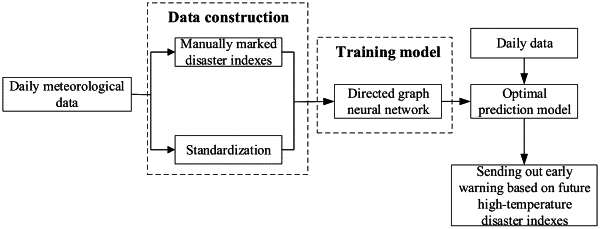| CPC G01W 1/10 (2013.01) [G06N 3/044 (2023.01)] | 5 Claims |

|
1. A high-temperature disaster forecast method based on a directed graph neural network, comprising:
step S1: performing standardization processing on meteorological elements respectively to scale the meteorological elements into a same value range; according to high-temperature early warning levels, setting high-temperature disaster values to be 0, 1, 2 and 3 respectively representing no high-temperature disaster, a high-temperature yellow early warning, a high-temperature orange early warning and a high-temperature red early warning; and encoding the high-temperature disaster values introducing a model into a discrete value vector (y1, y2, y3, y4) added into input data as a label;
constructing, according to time periodic characteristics of the meteorological elements, the meteorological elements obtained after performing the standardization processing into a multidimensional time series sample set based on a sliding window method; and
according to a setting ratio, dividing the multidimensional time series sample set into a training set, a verification set and a testing set;
step S2: constructing a directed graph neural network model, wherein a process of constructing the directed graph neural network model comprises:
for the directed graph neural network model, building mutual driving relationships among variables based on a graph, taking the meteorological elements as nodes in the graph, and describing relationships among the nodes by an adjacency matrix of graph; then learning node information by a stepwise learning strategy and continuously updating a state of the adjacency matrix; wherein the stepwise learning strategy comprises: a graph learning layer, starting from an initial state, adding a node to the graph during each time of learning, then using a recurrent neural network to calculate, based on autoregressive of node information, a similarity score, and generating a connection relationship between the node as added and each original node;
the recurrent neural network processing initial information of node and decoding a representation vector of node into a hidden state as input of a next iteration, wherein node information is continuously aggregated during an iteration process, and the iteration process is as follows:
M1=tan h(αE1Θ1);
M2=tan h(αE2Θ2);
A=(tan h(α(M1M2T+M2M1T)));
Ht=sigmod(W·xt+U·Ht−1);
where, W and U are hyperparameters, xt represents current input time series data; an expression of sigmoid function is
 and e represents a base of a natural logarithmic function; E1 and E2 represent randomly initialized node embeddings; Θ1 and Θ2 represent neural network model parameters; α represents a hyperparameter that controls a saturation rate of an activation function and is learned in a training process; A represents an adjacency matrix obtained after information aggregation based on nodes; Ht−1 represents an output hidden state of a previous iteration, and Ht represents a hidden state, namely the representation vector of node, of current iteration;
continuously updating a composition of the graph by aggregating the node information, and thereby obtaining a global adjacency matrix of graph;
constructing the directed graph neural network model according to time periodic characteristics of meteorological data and the meteorological elements, wherein the meteorological elements comprise daily maximum temperature, precipitation, wind speed, air humidity, sunshine hours, and evapotranspiration; the directed graph neural network model aggregating information of input data through embedded a graph convolutional module and a temporal convolutional module, comprising:
a graph learning module adaptively extracting an adjacency matrix of graph from input time series data according to the stepwise learning strategy as input of subsequent node information aggregating process of the graph convolution module; wherein a sampling method only calculates the similarity score between pairs of nodes each time, and the similarity score between the pairs of nodes is taken as a hidden state and aggregated in each calculation process to obtain the global adjacency matrix of graph;
wherein the graph convolutional module is composed of two mixed propagation layers respectively processing inflow information and outflow information of each node, each of the two mixed propagation layers comprises an information propagation process and an information selection process, the information propagation process is configured to transmit node information based on a graph structure given by the adjacency matrix of graph, and the information selection process is configured to filter noise generated in the information propagation process;
wherein an attention mechanism is added in the information propagation process by that edges connecting nodes in the adjacency matrix of graph are given different weights according to a formula as follows:
Ht=βHt−1;
where β represents the weight of each of the edges; Ht−1 represents the output hidden state of the previous iteration; Ht represents the hidden state, namely the representation vector of node, of the current iteration;
step S3: training the directed graph neural network model after determining a loss function, obtaining a model satisfying requirements by adjusting a learning rate, an optimizer and regularization parameters as a forecast model, and saving the forecast model; and
step S4: inputting historical multivariable time series into the forecast model, changing an output stride according to demands, and thereby obtaining high-temperature disaster forecast for a future period of time;
wherein the method further comprises:
applying the high-temperature disaster forecast in providing support for decision-makings of meteorological departments and providing reference for people's daily activities.
|